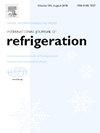基于人工智能模型的低gwp纯R1234yf及其纳米颗粒混合物替代气体的机械蒸汽压缩制冷系统的实验能量和火用评估
IF 3.5
2区 工程技术
Q1 ENGINEERING, MECHANICAL
International Journal of Refrigeration-revue Internationale Du Froid
Pub Date : 2025-06-17
DOI:10.1016/j.ijrefrig.2025.06.017
引用次数: 0
摘要
对当前制冷剂对全球变暖和臭氧消耗的影响的关注加速了替代品的发展。在本工作中,建立了两种不同的人工神经网络(ANN)结构来估计性能系数(COPR)、火用效率(ηex)、等熵效率(ηisen)和总火用破坏(Exdest_Total)作为输出的参数。在机械蒸汽压缩制冷系统(VCRS)中使用碳纳米管(CNTs)纳米颗粒代替传统制冷剂R134a。在实验情况下,采用能量和火用方法,在同一体系中研究了用纯R1234yf、R1234yf+Al2O3、R1234yf+石墨烯和R1234yf+ CNTs代替R134a。在网络拓扑中,所有数据点的70%用于训练,15%用于验证,15%用于测试。最后,将测量值和计算值作为输入参数的Levenberg-Marquardt学习算法作为多层感知器(Multilayer Perceptron, MLP)模型的训练算法进行评估。测定系数均大于0.99。平均偏差小于0.01%。高精度预测使基于r1234yf的纳米制冷剂能够快速优化性能,为制造商提供了一种经过验证的工具,以符合即将出台的制冷剂法规,同时最大限度地降低实验成本和系统重新设计的工作量。这种人工智能框架弥合了纳米粒子增强热力学和工业部署能力之间的差距。本文章由计算机程序翻译,如有差异,请以英文原文为准。
Experimental energy and exergy assessments of a mechanical vapor compression refrigeration system having low-GWP alternative gas of pure R1234yf and its nanoparticle mixtures using artificial intelligence models
Concerns about the effects of current refrigerants on global warming and ozone depletion have accelerated the development of alternatives. In the current work, two different Artificial Neural Network (ANN) structures were established to estimate the parameters Coefficient of Performance (COPR), exergy efficiency (ηex), isentropic efficiency (ηisen) and total exergy destruction (Exdest_Total) as outputs based on the experimental data of the alternative refrigerant R1234yf containing aluminum oxide (Al2O3), graphene, and Carbon Nanotubes (CNTs) nanoparticles instead of the conventional refrigerant R134a in a mechanical Vapor Compression Refrigeration System (VCRS). In experimental cases, the use of pure R1234yf, R1234yf+Al2O3, R1234yf+graphene, and R1234yf+ CNTs instead of R134a was experimentally investigated with energy and exergy approaches at same system. In network topologies, 70 % of all data points were utilized for training, 15 % for validation, and 15 % for testing. Finally, the Levenberg-Marquardt learning algorithms with measured and calculated values as input parameters were assessed as the training ones in Multilayer Perceptron (MLP) models. The coefficients of determination were greater than 0.99. The average deviations were smaller than 0.01 %. The high-accuracy predictions enable rapid performance optimization of R1234yf-based nanorefrigerants, providing manufacturers with a validated tool to comply with impending refrigerant regulations while minimizing experimental costs and system redesign efforts. This AI framework bridges the gap between nanoparticle-enhanced thermodynamics and industrial deploy ability.
求助全文
通过发布文献求助,成功后即可免费获取论文全文。
去求助
来源期刊
CiteScore
7.30
自引率
12.80%
发文量
363
审稿时长
3.7 months
期刊介绍:
The International Journal of Refrigeration is published for the International Institute of Refrigeration (IIR) by Elsevier. It is essential reading for all those wishing to keep abreast of research and industrial news in refrigeration, air conditioning and associated fields. This is particularly important in these times of rapid introduction of alternative refrigerants and the emergence of new technology. The journal has published special issues on alternative refrigerants and novel topics in the field of boiling, condensation, heat pumps, food refrigeration, carbon dioxide, ammonia, hydrocarbons, magnetic refrigeration at room temperature, sorptive cooling, phase change materials and slurries, ejector technology, compressors, and solar cooling.
As well as original research papers the International Journal of Refrigeration also includes review articles, papers presented at IIR conferences, short reports and letters describing preliminary results and experimental details, and letters to the Editor on recent areas of discussion and controversy. Other features include forthcoming events, conference reports and book reviews.
Papers are published in either English or French with the IIR news section in both languages.

 求助内容:
求助内容: 应助结果提醒方式:
应助结果提醒方式:


